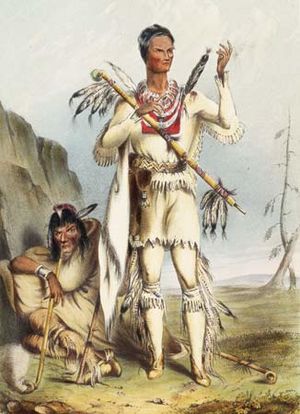Red Bird facts for kids
Quick facts for kids
Red Bird
|
|
|---|---|
| Ho-Chunk: Wanig-suchka | |

Red Bird dressed in white buckskin for his surrender to U.S. authorities
|
|
| Leader of the Winnebago (or Ho-Chunk) leader | |
| Personal details | |
| Born | c. 1788 |
| Died | 16 February 1828 (aged roughly 40) Prairie du Chien, Wisconsin |
| Known for | Leader in the Winnebago War against the United States |
Red Bird (born around 1788 – died February 16, 1828) was an important leader of the Winnebago, also known as the Ho-Chunk tribe. He became famous for leading his people in the Winnebago War of 1827. This conflict was against the United States as American settlers moved onto tribal lands to mine for lead.
For many years, Red Bird was seen as one of the most trusted and friendly Native American leaders in Wisconsin. However, in the late 1820s, Red Bird and his followers grew worried. Lead miners were moving deeper into Ho-Chunk territory, causing problems.
Contents
Growing Tensions
The Ho-Chunk people and the American settlers had different ideas about justice and land ownership. This led to many disagreements. One major issue was when the Ho-Chunk tribe received wrong information. They heard that two of their people had been unjustly punished at Fort Snelling in 1826 for a crime they did not commit.
As white miners continued to take resources near Ho-Chunk villages, the U.S. government became concerned. They wanted to prevent tribes from mining the same areas. This was because they feared it would lead to more conflict over the land.
The Prairie du Chien Incident
By June 28, 1827, Red Bird was very upset about how his tribe was being treated. Their lands were being taken, some tribal members were unfairly held, and violence was increasing. Under pressure from his people to protect their interests, Red Bird decided to act.
He set out with two companions, Chickhonsic (The Little Buffalo) and Wekau (The Sun). They met a trader named John Lockwood and a former British soldier, Duncan Graham. Both advised Red Bird against using violence.
However, the situation soon escalated. Red Bird's group arrived at the cabin of Registre Gagnier. Gagnier welcomed them inside. But he soon became suspicious and reached for his rifle. At that moment, Chickhonsic attacked Solomon Lipcap. Wekau tried to harm Mrs. Gagnier, but she and her son managed to escape. They quickly went to Prairie du Chien to warn others.
The Winnebago War Begins
Just two days later, on June 30, 1827, a group of Ho-Chunk people attacked an American boat called the Oliver Perry. During this attack, two crew members died, and several others were injured.
With the threat of a larger conflict, local militias were called up. Federal troops were also sent to Prairie du Chien from Jefferson Barracks, Missouri.
Red Bird's Surrender
Despite Red Bird's messages, the Ho-Chunk tribe was generally hesitant to go to war. Red Bird and his companions decided to surrender. They gave themselves up at Portage on September 2, 1827.
Red Bird expected to be put to death, but instead, he was taken to Prairie du Chien. He died in prison on February 16, 1828. He was about 40 years old. Several months later, the other Native Americans involved in the conflict were pardoned.
Red Bird's surrender was a very dramatic event in Wisconsin's history. This proud and respected chief became the subject of many stories, paintings, and plays.

